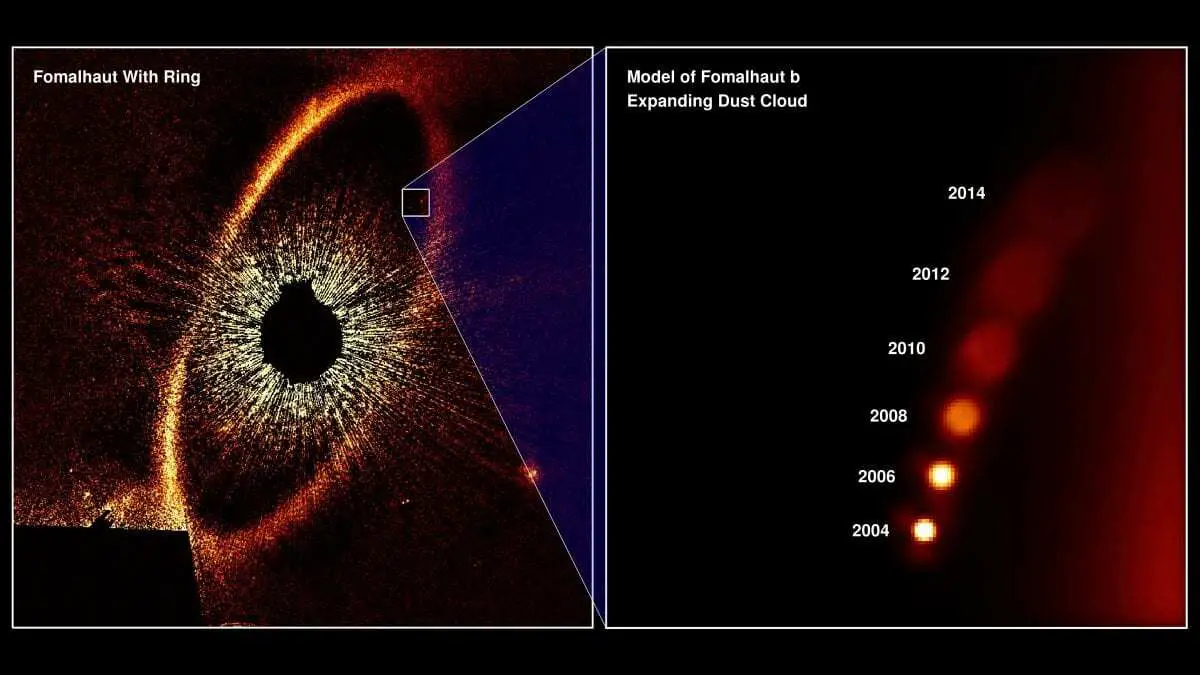What astronomers thought was a planet beyond our solar system, has now seemingly vanished from sight.
Astronomers now suggest that a full-grown planet never existed in the first place. The NASA/ESA Hubble Space Telescope had instead observed an expanding cloud of very fine dust particles caused by a titanic collision between two icy asteroid-sized bodies orbiting the bright star Fomalhaut, about 25 light-years from Earth.
“The Fomalhaut system is the ultimate test lab for all of our ideas about how exoplanets and star systems evolve,” said George Rieke of the University of Arizona’s Steward Observatory. “We do have evidence of such collisions in other systems, but none of this magnitude has ever been observed. This is a blueprint for how planets destroy each other.”
The object was previously believed to be a planet, called Fomalhaut b, and was first announced in 2008 based on data taken in 2004 and 2006. It was clearly visible in several years of Hubble observations that revealed it as a moving dot. Unlike other directly imaged exoplanets, nagging puzzles with Fomalhaut b arose early on. The object was unusually bright in visible light, but did not have any detectable infrared heat signature. Astronomers proposed that the added brightness came from a huge shell or ring of dust encircling the object that may have been collision-related. Also, early Hubble observations suggested the object might not be following an elliptical orbit, as planets usually do.

“These collisions are exceedingly rare and so this is a big deal that we actually get to see one,” said András Gáspár of the University of Arizona. “We believe that we were at the right place at the right time to have witnessed such an unlikely event with the Hubble Space Telescope.”
“Our study, which analysed all available archival Hubble data on Fomalhaut b, including the most recent images taken by Hubble, revealed several characteristics that together paint a picture that the planet-sized object may never have existed in the first place,” [1] said Gáspár.
Hubble images from 2014 showed the object had vanished, to the disbelief of the astronomers. Adding to the mystery, earlier images showed the object to continuously fade over time. “Clearly, Fomalhaut b was doing things a bona fide planet should not be doing,” said Gáspár.
The resulting interpretation is that Fomalhaut b is not a planet, but a slowly expanding cloud blasted into space as a result of a collision between two large bodies. Researchers believe the collision occurred not too long prior to the first observations taken in 2004. By now the debris cloud, consisting of dust particles around 1 micron (1/50th the diameter of a human hair), is below Hubble’s detection limit. The dust cloud is estimated to have expanded by now to a size larger than the orbit of Earth around our Sun.
Equally confounding is that the object is not on an elliptical orbit, as expected for planets, but on an escape trajectory, or hyperbolic path. “A recently created massive dust cloud, experiencing considerable radiative forces from the central star Fomalhaut, would be placed on such a trajectory” Gáspár said, “Our model is naturally able to explain all independant observable paramters of the system: its expansion rate, its fading and its trajectory.”
Because Fomalhaut b is presently inside a vast ring of icy debris encircling the star, the colliding bodies were likely a mixture of ice and dust, like the cometary bodies that exist in the Kuiper belt on the outer fringe of our solar system. Gáspár and Rieke estimate that each of these comet-like bodies measured about 200 kilometers across. The also suggest that the Fomalhaut system may experience one of these collision events only every 200 000 years.
Gáspár, Rieke, and other astronomers will also be observing the Fomalhaut system with the upcoming NASA/ESA/CSA James Webb Space Telescope, which is scheduled to launch in 2021.
Header Image – Data from the NASA/ESA Hubble Space Telescope have revealed an expanding cloud of dust produced in a collision between two large bodies orbiting the bright nearby star Fomalhaut. This is the first time such a catastrophic event around another star has been imaged. Credit : ESA/NASA, M. Kornmesser





